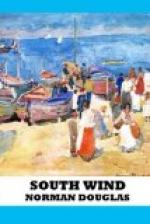Forthwith a change came over Mr. Ernest Eames. His frozen classical mind blossomed under the sunny stimulus of the Renaissance scholar. He entered upon a second boyhood—a real boyhood, this time, full of enthusiasms and adventures into flowery by-paths of learning. Monsignor Perrelli absorbed him. He absorbed Monsignor Perrelli. Marginal observation led to footnotes; footnotes to appendixes. He had found an interest in life. He would annotate the antiquities.
In the section which deals with the life of Saint Dodekanus the Italian had displayed more than his usual erudition and acumen. He had sifted the records with such incredible diligence that little was left for the pen of an annotator, save words of praise. In two small matters, however, the Englishman, considerably to his regret, was enabled or rather obliged to add a postscript.
Many a time he cursed the day when his researches among the archives of the mainland brought him into contact with the unpublished chronicle of Father Capocchio, a Dominican friar of licorous and even licentious disposition, a hater of Nepenthe and a personal enemy, it seemed, of his idol Perrelli. His manuscript—the greater part of it, at all events—was not fit to be printed; not fit to be touched by respectable people. Mr. Eames felt it his duty to waive considerations of delicacy. In his capacity of annotator he would have plunged headlong into the Augean stables, had there been any likelihood of extracting therefrom the germs of a luminous footnote. He perused the manuscript, making notes as he went along. This wretched monk, he concluded, must have possessed a damnably intimate knowledge of Nepenthean conditions, and a cantankerous and crapulous turn of mind, into the bargain. He never lost an opportunity of denigrating the island; he was determined, absolutely determined, to see only the bad side of things, so far as that place was concerned.
Regarding the pious relic, for instance,—the thigh-bone of the saint, preserved in the principal church—he wrote:
“A certain Perrelli who calls himself historian, which is as though one should call a mule a horse, or an ass a mule, brays loudly and disconnectedly about the femur of the local god. We have personally examined this priceless femur. It is not a femur, but a tibia. And it is the tibia not of a saint, but of a young cow or calf. We may mention, in passing, that we hold a diploma in anatomy from the Palermitan Faculty of Medicine.”
That was Father Capocchio’s way: bald to coarseness, whenever he lacked occasion to be obscene.




